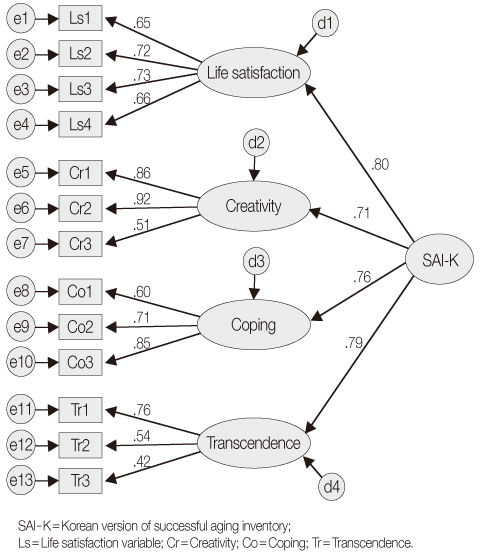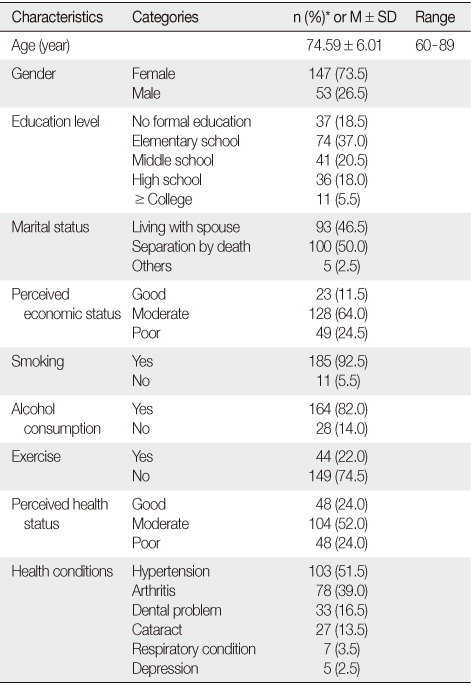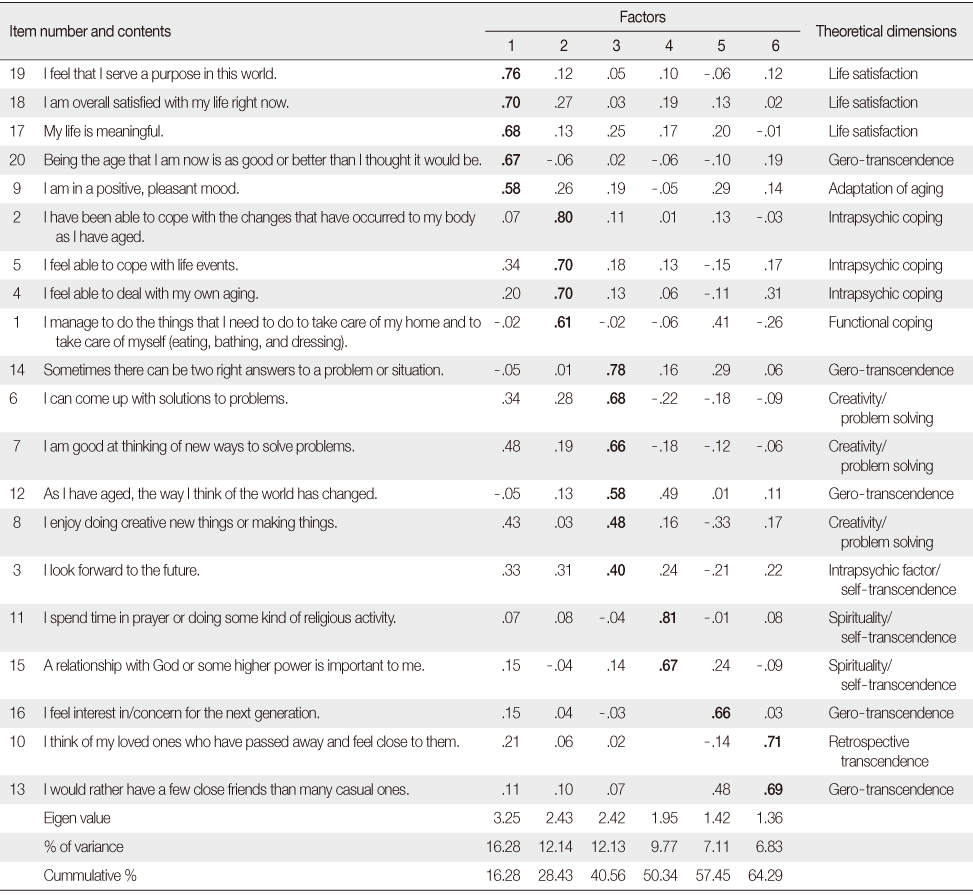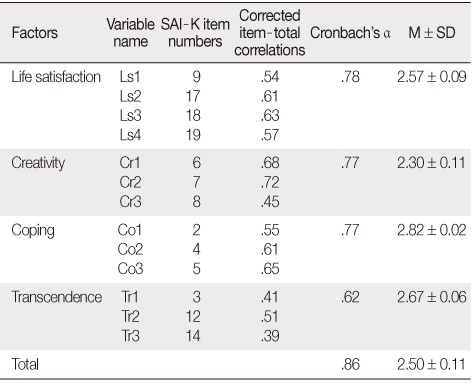Articles
- Page Path
- HOME > J Korean Acad Nurs > Volume 43(4); 2013 > Article
-
Original Article
- Accessing Factor Structure and Construct Validity of the Successful Aging Inventory
- Eun Joo Kim
-
Journal of Korean Academy of Nursing 2013;43(4):568-578.
DOI: https://doi.org/10.4040/jkan.2013.43.4.568
Published online: August 30, 2013
Department of Nursing, Daejeon University, Daejeon, Korea.
- Address reprint requests to: Kim, Eun Joo. Department of Nursing, Daejeon University, 62 Daehak-ro, Dong-gu, Daejeon 300-716, Korea. Tel: +82-42-280-2656, Fax: +82-42-280-2785, ejkim@dju.kr
© 2013 Korean Society of Nursing Science
Abstract
-
Purpose
- The purpose of this study was to evaluate the reliability and validity of the Korean version of the Successful Aging Inventory (SAI-K) to determine its suitability for use with older Korean adults.
-
Methods
- Exploratory and confirmatory factor analyses were utilized to assess the factor structure and the construct validity of the SAI-K. First- and second-order Confirmatory Factor Analysis (CFA) were conducted to identify the most adequate model. Cronbach's alpha was used to test the reliability.
-
Results
- Using a second-order CFA, a four-factor structure was validated (χ2=122.82, p<.001, GFI=.92, AGFI=.88, SRMR=.06 RMSEA=.07, 90% CI=.05-.09, CFI=.93). The four-factor SAI-K showed reliable internal consistency with a Cronbach's alpha for the total scale of .86.
-
Conclusion
- The four-factor, 13-item SAI-K showed satisfactory reliability and validity and, thus, has the potential to be an appropriate instrument for measuring successful aging in older Korean adults.
- 1. An JS, Chong YS, Jeong YJ, Seo SG, Cooney TM. Critical aspirations from studies of successful aging. Korean J Dev Psychol. 2011;24(3):35–54.
- 2. Bae BR. Structural equation modeling with Amos 17.0: Principles and practice. 2nd ed. Seoul: CheongRam Books; 2009.
- 3. Cheon JS, Byun IW, Song HR, Oh BH. Factors related to the morale of Korean elders. J Korean Geriatr Psychiatry. 2004;8(1):56–62.
- 4. Depp CA, Jeste DV. Definitions and predictors of successful aging: A comprehensive review of larger quantitative studies. Am J Geriatr Psychiatry. 2006;14(1):6–20. http://dx.doi.org/10.1097/01.JGP.0000192501.03069.bcArticlePubMed
- 5. Eun Y, Sohng KY, Park OJ, Ko SH, Park MH, Kim JS, et al. Advanced clinical gerontological nursing. 2nd ed. Seoul: Hyunmoonsa; 2010.
- 6. Field A. Discovering statistics using SPSS. 3rd ed. London, UK: Sage Publications Ltd; 2009.
- 7. Flood M. Successful aging: A concept analysis. J Theory Constr Test. 2002;6(2):105–108.
- 8. Flood M. A mid-range nursing theory of successful aging. J Theory Constr Test. 2005;9(2):35–39.
- 9. Flood M, Scharer K. Creativity enhancement: Possibilities for successful aging. Issues Ment Health Nurs. 2006;27(9):939–959. http://dx.doi.org/10.1080/01612840600899832ArticlePubMed
- 10. Grove SK, Burns N, Gray JR. The practice of nursing research: Appraisal, synthesis, and generation of evidence. 7th ed. St. Louis, MO: Elsevier Inc; 2012.
- 11. Hair JF, Tatham RL, Anderson RE, Black W. Multivariate data analysis. 5th ed. Upper Saddle River, NJ: Prentice Hall; 1998.
- 12. Han SS, Lee SC. Nursing and health statistical analysis. Seoul: Hannarae Publishing Co; 2012.
- 13. Harrington D. Confirmatory factor analysis. New York, NY: Oxford University Press Inc; 2009.
- 14. Kim DB. The study on the development of the Korean elderly's successful aging scale. Korean J Soc Welf. 2008;60(1):211–231.Article
- 15. Kim EJ, Kim Y. Predictors of successful aging in Korean older women based on successful aging theory (SAT). Korean J Women Health Nurs. 2011;17(4):378–387. http://dx.doi.org/10.4069/kjwhn.2011.17.4.378ArticlePubMed
- 16. Kim MH, Shin KR. The study on the development of the 'successful aging' scale for Korean elderly. J Korea Gerontol Soc. 2005;25(2):35–52.
- 17. Kline RB. Principals and practice of structural equation modeling. New York, NY: Guilford Press; 1998.
- 18. Lee EO, Lim NY, Park HA, Lee IS, Kim JI, Bae JY, et al. Nursing research and statistical analysis. 4th ed. Paju: Soomoonsa; 2009.
- 19. Munro BH. Lee EH Chung Y Kim JS Song R Hwang KY . Statistical methods for health care research. 4th ed. Philadelphia, PA: Lippincott Williams & Wilkins; 2001.
- 20. Nunnally JC, Bernstein IH. Psychometric theory. 3rd ed. New York, NY: McGraw-Hill; 1994.
- 21. Reed PG. Self-transcendence theory. In: Smith MJ, Liehr PR, editors. Middle range theory for nursing. New York, NY: Springer Publishing Company, LLC; 2008. p. 105–130.
- 22. Rowe JW, Kahn RL. Human aging: Usual and successful. Science. 1987;237(4811):143–149.ArticlePubMed
- 23. Song JJ. SPSS/AMOS statistical analysis. 2nd ed. Paju: 21cbook; 2012.
- 24. Song TM, Kim GS. Structural equation modeling for health & welfare research. Seoul: Hannarae Publishing Co; 2012.
- 25. Troutman M, Nies MA, Small S, Bates A. The development and testing of an instrument to measure successful aging. Res Gerontol Nurs. 2011;4(3):221–232. http://dx.doi.org/10.3928/19404921-20110106-02ArticlePubMed
- 26. Van Prooijen JW, Van der Kloot WA. Confirmatory analysis of exploratively obtained factor structures. Educ Psychol Meas. 2001;61(5):777–792. http://dx.doi.org/10.1177/00131640121971518ArticlePDF
- 27. Yu JP. Structural equation models: Concepts and understanding. Seoul: Hannarae Publishing Co; 2012.
REFERENCES
Figure & Data
REFERENCES
Citations

- Development and Validation of a Perceived Community Food Accessibility Measurement Questionnaire for Korean Older Adults
Jisoo Hong, Narae Yang, Kirang Kim
Nutrients.2023; 15(19): 4301. CrossRef - Effects of Health Status, Depression, Gerotranscendence, Self-Efficacy, and Social Support on Healthy Aging in the Older Adults with Chronic Diseases
Hee-Kyung Kim, Jeong-Hyo Seo
International Journal of Environmental Research and Public Health.2022; 19(13): 7930. CrossRef - Item response analysis to explore psychometric properties of the Persian version of Troutman successful aging inventory: Rasch partial credit model
Mozhgan Seif, Abdolrahim Asadollahi, Mahsa Yarelahi, Elham Rezaian
Journal of Health Psychology.2021; 26(14): 2711. CrossRef - Successful aging and environmental factors in older individuals in urban and rural areas: A cross-sectional study
Wenxiu Ding, Yanqi Zhang, Liyao Zhang, Zhaoxiu Wang, Jie Yu, Hong Ji
Archives of Gerontology and Geriatrics.2020; 91: 104229. CrossRef - Contributions of Psychosocial Factors and Physical Activity to Successful Aging
Melchor Gutiérrez, José Manuel Tomás, Pablo Calatayud
The Spanish Journal of Psychology.2018;[Epub] CrossRef - The effects of patient education on patient safety: can we change patient perceptions and attitudes?: Lessons from the Armed Forces Capital Hospital in Korea
JinOk An, Seung Ju Kim, Sohee Park, Ki Tae Moon, Eun-Cheol Park
International Journal for Quality in Health Care.2017; 29(3): 392. CrossRef - Disjoint factor analysis with cross-loadings
Maurizio Vichi
Advances in Data Analysis and Classification.2017; 11(3): 563. CrossRef - Successful Aging and the Influencing Factors in the Korean Elderly: Focused on Family Support
SongYi Han, Soon-Nyung Yun
Journal of Korean Academy of Community Health Nursing.2015; 26(4): 372. CrossRef - Reliability and Validity of the Korean Version of the European Organization for Research and Treatment of Cancer Quality of Life Questionnaire to Assess Chemotherapy-induced Peripheral Neuropathy
Hye Young Kim, Jeong Hee Kang, Hyun Jo Youn, Hyang Sook So, Chi Eun Song, Seo Young Chae, Sung Hoo Jung, Sung Reul Kim, Ji Young Kim
Journal of Korean Academy of Nursing.2014; 44(6): 735. CrossRef - Testing the Validity and Reliability of Korean Version of the Expectations Regarding Aging (ERA-12) Instrument among Middle-aged and Elderly Women
Min Hee Park, Yoorim Kweon
Journal of Korean Public Health Nursing.2014; 28(3): 460. CrossRef - Construct Validity of the Life Transition Scale for Parents of Children with Autism
Ae Ran Lee, Sun Woo Hong, Se Jin Ju
Journal of Korean Academy of Nursing.2014; 44(5): 563. CrossRef

Figure 1
General Characteristics of Participants ( N =200)
*Missing responses excluded.
SAI-K Factor Loadings from EFA and Theoretical Dimensions Represented
SAI-K=Korean version of successful aging inventory; EFA=Exploratory factor analysis.
Model Fitness Test Results
CFA=Confirmatory factor analysis; CMIN/DF=Chi-square minimum/degree of freedom; GFI=Goodness of fit index; AGFI=Adjusted goodness-of-fit index; RMR=Root mean square residual; RMSEA=Root mean square error of approximation; CI=Confidence interval; NFI=Normed fit index; CFI= Comparative fit index.
Reliability Coefficients for SAI-K
SAI-K=Korean version of successful aging inventory; Ls=Life satisfaction; Cr=Creativity; Co=Coping; Tr=Transcendence.
*Missing responses excluded.
SAI-K=Korean version of successful aging inventory; EFA=Exploratory factor analysis.
CFA=Confirmatory factor analysis; CMIN/DF=Chi-square minimum/degree of freedom; GFI=Goodness of fit index; AGFI=Adjusted goodness-of-fit index; RMR=Root mean square residual; RMSEA=Root mean square error of approximation; CI=Confidence interval; NFI=Normed fit index; CFI= Comparative fit index.
SAI-K=Korean version of successful aging inventory; Ls=Life satisfaction; Cr=Creativity; Co=Coping; Tr=Transcendence.
 KSNS
KSNS
 E-SUBMISSION
E-SUBMISSION





 Cite
Cite

